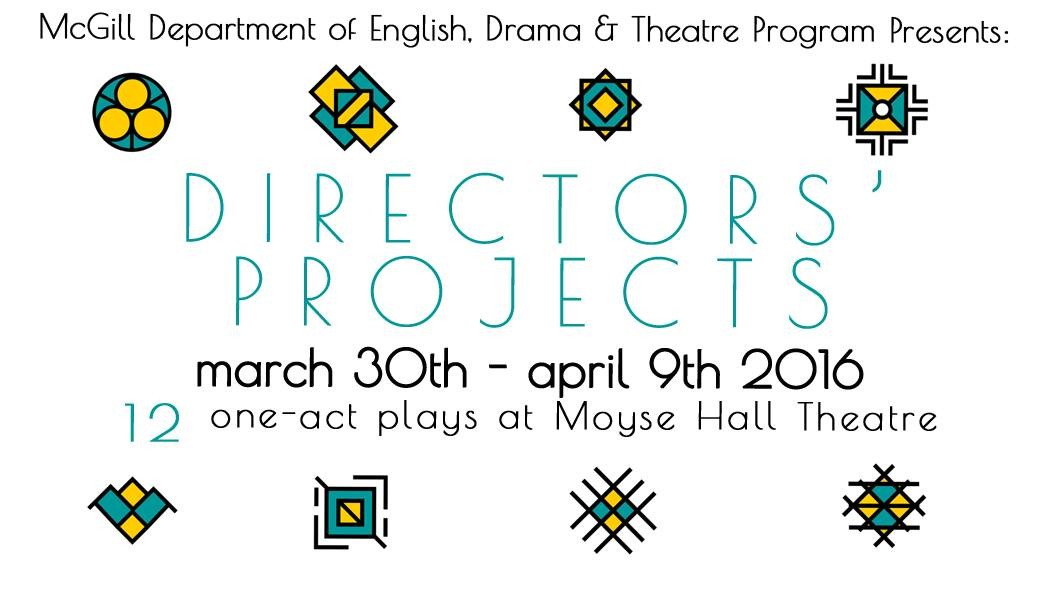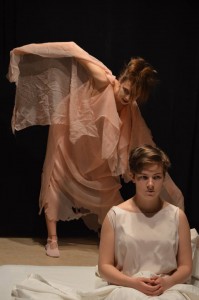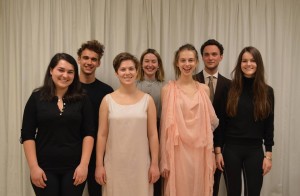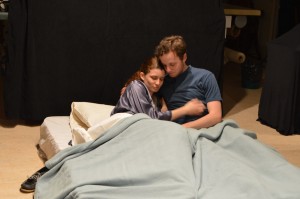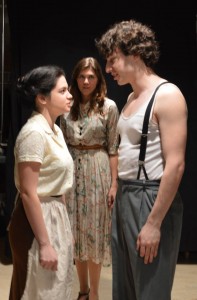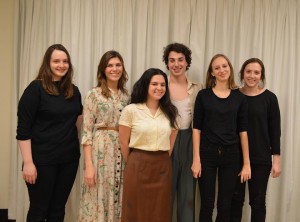By: Michelle Guo
The collaborative minds of McGill’s English, Drama & Theatre Department have come together to present the Directors’ Project in a festival format with 12 unique one-act plays that tackle the themes of family, the body versus the mind, and human connection. Since September, each crew has been working tirelessly on their respective shows. The festival features shows directed by McGill students who auditioned for the directing class offered by the Drama and Theatre program last spring and were then hand-picked to direct these shows. This course is offered every 2 years at McGill but this is first time the show has been done in collaboration with students from the staging/scenery and costuming classes. All of the costumers and set students were paired up with a show where they have been applying their classroom skills on to the real stage. We sat down with three of the eleven directors: Oscar of “A Kind of Alaska”, Anna of “Three More Sleepless Nights”, and Sarah of “Night of Assassins” who discussed the directing process, their personal connections to the plays, and the topics explored along the journey.
“A Kind of Alaska”
“… And so, you’re asking yourself, when you direct the play and when you’re acting this part, which life is more important? The one that was spent in the head or the one that was spent outside of the body?”
B&B: Could you summarize your play for me in one sentence?
Oscar: “A woman wakes up though she doesn’t know if she has woken up from sleep or from death and to help her in this are a strange man and a woman who claims to be her sister.”
B&B: You mention growing up in multilingual communities, how has that helped you with the direction of this play?
Oscar: “Well I’m French and I’m always talking in a foreign language over here and I’ve noticed and witnessed myself that when I switch from French to English, my personality and my attitudes change a bit with regards to things, people, and the way I behave. In a play like this where a woman is affected by a disease, which traps her in her body and makes her unable to move for over 30 years; how is that experience the same for everyone? Because this is a sickness rather, which affected people all over the world with the same symptoms, so people who come from different cultures and different languages were having the same experience and so there isn’t really a language to describe what is happening when these individuals become trapped in their bodies. It’s definitely the multilingual [aspect] and the wanting to appeal universally, and to create meaning universally, which has come through the addition of a dancer who dances the part of Deborah, the main patient who is played by two different girls; one who is speaking and one who is dancing. The one who is speaking is to conserve the interest of performing the play in an English speaking community in Montreal at McGill and the dancer is the attempt, successful I think, to have the same story and the same struggles be told without relying on a language or our words.”
B&B: Body versus mind seems to be one of the main themes of “A Kind of Alaska”, what do you think are the complications that come with this conflict?
Oscar: “Well, Oliver Sacks, who is the man that wrote the book that my play is based on called Awakenings, theorizes that movement is a way in which we conceive time pass and that’s true; we also kind of associate time and space together and we never really disassociate them from each other. So, when someone asks you how far something is, you could say “2 hours away” or “50 kilometres away” and you usually speak in those types of binaries that either is how much your experience of travelling – let’s say that I was travelling to Quebec City I could say it was 3 hours or 300 kilometres, 3 hours would be how my own experience of travelling there was and 300 kilometres is the actual displacement that I put in my body; my body was in Montreal before and now it’s in Quebec City, but I could’ve slept the whole way there and it wouldn’t have felt 3 hours or 300 kilometres. So when someone becomes trapped in their body but is still fully conscious[…] they’re passive on the outside, yet potentially so active on the inside. How do you conceptualize the idea of time passing if you’re unable to move? This the story of a 16 year old girl who falls into this inability to move, this coma, and she then spends 30 years unable to move, creates a life inside her head full of hallucinations and full of myths and stories that she creates for herself and is snapped out with an injection, just like that. And so, you’re asking yourself, when you direct the play and when you’re acting this part, which life is more important? The one that was spent in the head or the one that was spent outside of the body? Can we essentially live without moving?”
B&B: Would you rather have the body of an elderly person and a young mind or a young person but aging mind?
Oscar: “I think this question is very easy. I would definitely pick the young body and the aging mind because it seems to have all the advantages right there.”
B&B: How did the idea of incorporating dance into your play come about?
Oscar: “Well I’ve been involved in theatre for a while now and 4 years ago I acted in a production of Macbeth in which I played Macbeth along with someone else and that’s basically how I was introduced. And so, I’m working from something called Delsarte’s system of expression of expression, which was this system that was developed by a French opera singer and teacher who lost his voice mid-way through his career. The way in which he had thought to be able to make art and his medium essentially was taken away from him and he started developing this code to translate language into the physical body because he was mute and still wanted to perform operas even though he was not able to sing.
He thought, “how can the range of notes and how can the range that is present in opera and the tradition of opera be translated to the body?”And so, in the interest of having the universal experience of this sickness as experienced by everyone(by audience members may have different levels of English and who may be coming from different places and culture’s) there’s this thing called audience expectation and circumstances that the audience comes into theatre with. In the sense that you or I might come into to see a same play, but since we are two different individuals with two different lives entirely, we may have a completely different experience with the play with regards to the rest of our lives. So, using the dancer and using this idea of translating and not relying on the voice was in an effort to create a performance which would be universally emotive and create meaning and emotion without having to depend on cultural barriers, which I think language is. I’ve been working with physical theatre for years and it’s a co-created production in which I simply come in with a general vision of what I want to do but ultimately, it’s what my actors have which will take the play where it has.”
B&B: What plays inspire your direction? Who are your influences?
Oscar: “I think my one of my biggest influences would probably be this company whose name is Punchdrunk. They’re an international company now but they come from the UK and they are famous for shows like the “The Drowned Man” in London and “Sleep No More” in New York. They’re a mask company, basically, and what they do is they rent out warehouses and turn the warehouse into a living theatre where all the audience members wear masks and their actors do not. The actors move throughout the building-there’s no stage- and the audience moves how they like, they may choose to follow character A for a while or if they get bored of them, follow character B. What Punchdrunk does essentially is it takes a play and it expands its world to a maximum level. In a play, for example, Bob leaves the stage, well what does Bob do? And what Punchdrunk does in its productions, its called immersive theatre, which is what I’m dealing with in this play, is you can actually go follow Bob and do whatever Bob is doing there. And so have a completely total experience of all the characters of the play. That is probably my main influence and Punchdrunk does all of their shows non-spoken because they have such a wide international audience and if they were to speak in the warehouse they could be heard elsewhere so its all movement work and body-based work.”
“Three More Sleepless Nights”
“…They’re struggling with how to literally connect with a person who’s in the same room as you who you’re supposed to know for years, and whom you share a life with, and there’s this barrier constantly at play between you and the other person. So the entire play is a struggle to find a way to break that barrier and ultimately, it begs the question of ‘can we really, as humans, break that barrier?'”
B&B: Could you summarize your play for me in one sentence?
Anna: “Four individuals grapple with their identities and struggle with finding communications and connections over three nights without sleep.”
B&B: You wrote how many pursuits are clashing in your play. Can you provide some detail into that?
Anna: “Just like any good play, the play is not centred on one theme but rather explores many different psychological and other aspects of the characters. And so all of the characters that are present are conflicted with many issues been thrown at them, if that makes sense. For example, they’re struggling with how to literally connect with a person who’s in the same room as you who you’re supposed to know for years and whom you share a life with and there’s this barrier constantly at play between you and the other person. So the entire play is a struggle to find a way to break that barrier and ultimately it begs the question of can we really as humans break that barrier? So that’s one of the pursuits. Another one is your own identity, [in the play]: we see two of the characters come back in a different time and place at the end of the play and there’s this very phenomenal question of whether or not anything changed for them. It’s implied very directly that yes it is but if you go down deeper into yourself, have you really changed? Is that possible? Is that a good or bad thing? And none of these questions are really answered and that is what I love about the play and the process is that we’ve been answering a lot of questions and they still remain unanswered and it’s partially up to the audience to answer them.”
B&B: What does the concept of home mean to you and how does that manifest itself into the play?
Anna: “This is a very interesting question since I’m grappling with that concept right now myself. Coming from Ukraine, being raised there and I’ve also in other places and countries, my family moved around a lot. So when people ask me where I’m from or where is home, I’m always taken aback by that question everytime and everytime something different comes up. In this play, this is also relevant because home for a lot of characters isn’t a place; it’s a person or people. This is reflected in our set design because it’s a suggestion of a bedroom, not a particular bedroom. You have a basic thing that is supposed to say to the audience that we’re inside. So home, isn’t a particular place; it’s not for me and [instead] it’s everything that makes you feel at home, that makes you feel , comforted, and communicated with. That concept is fluid, it’s not static and it’s not attached to particular physical thing and it is also explored throughout the play.”
B&B: Which character do you think the audience will relate to the most?
Anna: “I don’t think either of them to be honest. I think every character [will] hopefully brings something relevant to the audience and a lot of these characters, which is another, thing I find grappling with the play, are very different but they’re struggling with fundamentally the same kinds of things. A lot of similar issues come up in all the different characters if that makes sense. So, I don’t think it’s a particular character, it’s different things in each character.”

Three More Sleepless Nights cast and crew
B&B: What was the most challenging part with bringing the script to life?
Anna: “It has been making choices and interrupting everything without having to guess what Carol Churchill wanted because that’s impossible and that’s a useless and futile quest. It was making particular choices about particular things in the play at the same time- I say it’s a challenge but that’s one of the best things I’ve enjoyed about the process is making those choices and really diving deep. Another thing was putting everything together and making sure that an element or choice that is made in one part is consistent throughout the set, the lighting, and the costume design and everything else. That collaborative process and constant process has also been one of the best things about the process.”
B&B: Who is Carol Churchill, the writer?
Anna: “Carol Churchill is a contemporary British playwright who writes fantastic plays of various genres, lengths, etcetera. What I find is so compelling about her work is what she writes is so damn true and it’s so real and you wouldn’t think so from the way the words are often laid out on the page. She’s an eavesdropper in my opinion, she goes and she’s a very good witness of what’s actually happening around us. A lot of the themes she’s concerned about are things like communication, people, how do we use language, how do we find information in the world; it’s very often language intensive. She does wonderful things with the ways she uses language and words and she also leaves a lot of room for interpretation, most of the time has refused to comment on or explain her plays. She really leaves it up to the artist. She is also a fantastic activist and social presence. She’s a wonderful woman.”
B&B: What has been your favourite part working on the play?
Anna: “There’s not one favourite part but some of the favourite parts were really diving deep into the play, diving very very deep and there’s so much depth to go and I don’t think we’re fully there yet and I don’t think we ever will be and that’s what I love about the play. Doing so with a wonderful team and my actors have been very involved and very caring of the process and so have my stage manager, costume designer, and the entire crew of the festival. Really diving deep, I think and figuring things out; the entire process was a process of figuring things out and I feel like an investigator, you know, searching for cues and putting them together.”
“Night of Assassins”
“…Violence, family violence, trauma, what it means to have a life, how someone can give and take away your life, what it means to be trapped; essentially all the characters are trapped in a basement and can’t get out…the desire to get out but not being able to get out, and the desire to get out but not knowing for themselves…”
B&B: Could you summarize your play for me in one sentence?
Sarah: “The semiotics of violence.”
B&B: “Night of Assassins” deals with siblings who cope with trauma through role-playing. How do you think theatre and roleplaying are similar or different?
Sarah: “They are very similar. I don’t act but from an acting standpoint, every time you go on the stage, you’re playing a character. What’s interesting for my actors is that they had to play a character playing a character, and sometimes they had to play a character within the play playing another character, which is like kind of interesting to see how those kind of cross-overs and what it looks like to create. I mean there’s one point in the show where one actress goes very quickly and plays 4 characters. It’s very interesting to see how she can make all 4 characters fairly distinct from one another in a short period of time.”
B&B: Which character in the play are you most able to identify with?
Sarah: “That’s tough. I think the thing about the characters is that [the play] is set in Cuba right before the revolution so most of the show has very revolutionary subtext going on and so like, I would say I would want to be like Lalo but also not want to be like Lalo because he’s also pretty clinically insane by our standards in terms of what he says… All the characters are all very interesting!”
B&B:What was the most challenging part with bringing the script to life?
Sarah: “We had to choose a shorter play than I did and for the show. I was cutting a lot out of it, which is hard because you don’t want to get rid of anything and then second-guess yourself. As I mentioned, it’s also very politically minded and that’s difficult as it doesn’t ever talk about the revolution happening in those exact words, it’s more so, there’s a lot of things that are said that have such a big meaning so a lot of rehearsals consisted of me sitting down one-on-one with the actors and kind of saying sentence by sentence like ‘what does this mean?’ or ‘what do you think this means?’ It’s interesting because sometimes when you’re reading a full monologue and you might be like, ‘okay overall he is talking about the need to rebel,’ but then you look at lines like, ‘I felt my mother’s hands on my pillow scratching my face’; those kinds of things, it’s kind of interesting when you assign a very distinct role to each of those little thoughts that happen.”
B&B: What were the main themes you were trying to capture in “Night of Assassins”?
Sarah: “Definitely violence, family violence, trauma, what it means to have a life, how someone can give and take away your life, what it means to be trapped; essentially all the characters are trapped in a basement and can’t get out. We played around with the idea of being trapped in a birdcage and the claustrophobia that happens. The desire to get out but not being able to get out and the desire to get out but not knowing for themselves because they have never gotten to chose for themselves what it means to have a life. The characters are described as children but they’re actually in their 30s and it is more so adults who have never learned to function properly.”
B&B: What do you hope people to take away?
Sarah: “I think control is definitely a huge theme that comes up in the show and I think it might get people to think a little about their actions and how their actions affect other people. The grander scheme of that in terms of what is it that leaves someone to be at the point to kill his [Lalo’s] parents, it’s all of these little things combined with the fact that he’s not super mentally stable. Just seeing people’s influence… Lalo’s basically our revolutionary gung-ho character, Cuca, the older sister who tries to calm him down, not so much that she doesn’t want to this event to take place but more so she’s seeing the other side of it; ‘what happens if we get caught?’ The younger sister, Beba, is acting as an intermediary between the two and trying to kind of keep the peace and also knowing that something really wrong happening. She’s the one who voices the disdain for being in the room as much and it might be because she is younger and there might be a life outside for her whereas the other siblings definitely as resigned to be where they are.”
The Directors’ Festival is opening on March 30th and will run until April 9th at Moyse Hall in the Arts Building. Tickets cost $5 per show at the door. For more information on the festival including show times and the director’s notes of each play, visit the Facebook event page at: https://www.facebook.com/events/1685929655014183/ and website at: https://directorsfestival2016.wordpress.com/
Photos Courtesy of Catherine Bradley

